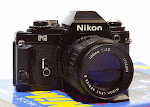We all have taken photos with wide-angle lenses while standing too close to our subject. The results from this technique can be very amusing, bordering on comedic. We get a distorted image of the model we photographed. This may be amusing for family and friends, but what about a paying client who wants an aesthetically perfect print?
Here one such example.

Why does this distortion occur? Lets take a look at normal perspective. One way our eye perceives near or far is by the relative size of a given object. Our mind tells us those objects further away are appear smaller.
Here’s another view, the closer the object, the stronger the effect of perspective.
If you were to photograph a train with 100 cars attached moving toward you and snapped a shot of the front engine about 15 feet from you, the engine will appear much larger than the rest of the cars. But if you photograph the train from 100 feet the difference in size between the engine and the rest of the train would not be so great.
This is true of all lenses:
The farther away an object, the smaller it appears.
The farther away the lens is from an object, the less the change in apparent size.
I hope this helps you to see why a wide-angle lens will cause perspective distortion. When we shoot with a wide-angle lens we tend to get closer to the subject before taking the picture. The closer you are the stronger the perspective effect.
Wide-angle lenses do not distort perspective any more than any other lens, provided you shoot your subject from the same distance as with all lenses. If you shoot a subject from 15 feet with a 100mm lens, 50mm lens, and a 24mm lens, the perspective will be the same provided you maintain the exact position. Simply crop the same portion of all your photos to the same size and you will see this is true. The perspective will be the same from all lenses.
The tip of the human nose is about an inch closer to the camera than the rest of the face. Because closer objects appear larger, the nose when shot up close will appear larger than the rest of the face. A wide-angle lens will make the distortion pronounced. Why? Because we need to fill the frame with our image and to do this we need to get closer with a wide-angle lens than we would with longer focal lengths. When you come in close with any size lens the distortion will be pronounced. The closer you are the more the distortion.
What about telephoto lenses?
Perspective distortion gets less and less as the subject gets farther away. Things begin to flatten out. Objects that are far away appear to stack on top of each other. This is a bit like reverse distortion, this effect is common when you shoot with a telephoto lens.
Because the subjects are very far from the camera you produce a flattened perspective.
LINEAR DISTORTION
Lines that are actually parallel do not appear to be parallel. This is linear distortion.
Have you ever taken a picture of a tall building and the photo looks as if the building is leaning when in reality it is not?
Linear Didtortion

Another perspective.

Perhaps you used a wide angle lens feeling that this would help to capture the entire building if you just aimed up a little bit.
What happens is by aiming upward you cause the sides of the building to converge toward the center creating normal perspective of depth. This would look natural if you take your shot from dead center of the building. What happens if your position is off? Well, the sides of the structure will not converge at the same angle. You may get an image where one wall appears straight up and down while the other wall is at a 30-degree angle.
Can you correct this problem? Sure, the answer is quite easy. Simply keep the back of your camera parallel to the face of the structure you are photographing. If you cant get the entire building in view simply move back or try a wider-angle lens.
Another option is a view camera. I wont cover that in this lesson; I will just stick to 35mm cameras.
But there is another option for the 35mm cameras, its called a PC lens. (Perspective control). The face of these lenses screw upwards, downwards, and sideways. As you look through your viewfinder you can see the image changing with the position of the lens. Just keep changing the lens position until you seethe image you want.
PC lenses do have limitations. First and foremost, they are expensive. Second, they have only a limited range of adjustment. If you think you can pull in the Sears Tower from across the street, forget it., you’ll need a view camera for that.
THE FISH-EYE LENS
A fish-eye is a lens of such extreme short focal length that its angle of view is close to 180 degrees. 16mm or less are generally considered fish-eye lenses.
When you hold a fish-eye at eye level and shoot straight ahead, the lens will take in everything in the hemisphere of space in front of you. The image will usually form a circle within a frame and not fill the rectangle. Distortion is tremendous, with perspective lines radiating out from the center directions. A straight line through the center will remain straight. Straight lines through any other part of the picture will curve.

No comments:
Post a Comment